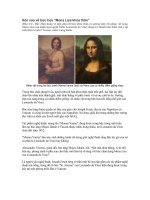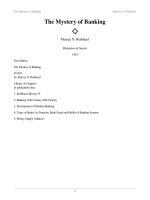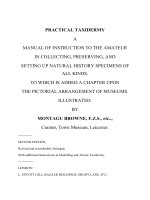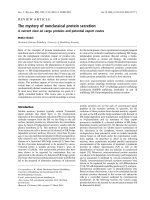943 history mystery of mona lisa
Bạn đang xem bản rút gọn của tài liệu. Xem và tải ngay bản đầy đủ của tài liệu tại đây (293.1 KB, 5 trang )
HISTORY
The Mona Lisa is 16th century oil painting created by the renowned Leonardo da Vinci. The work of art depicts an enigmatic woman gazing at the
viewer, and it is said that if you move across the room while looking into her eyes, they’ll follow you. It is definitely one of the most popular paintings
worldwide and has been the center of many artistic, religious, and theoretical debates. The French government currently owns the Mona Lisa and it is
featured at the Musee du Louvre in Paris. The painting can also be referred to as La Gioconda or La Joconde.
The name of the painting stems from the name of the woman in the portrait, Lisa Gherardini, the wife of a wealthy businessman in Florence, Italy named
Francesco del Giocondo. Mona means ‘my lady’ or ‘madam’ in modern Italian, so the title is simply Madam Lisa. Art historians agree that Leonardo da
Vinci likely began painting the Mona Lisa in 1503, and completed it within 4 years. In 1516 the King of France, King Francois, bought the painting and
it is thought that after Leonardo’s death the painting was cut down. Some speculators think that the original had columns on both sides of the lady,
whereas other art critics believe that the painting was never cut down in size. It has been suggested that there were 2 versions of the Mona Lisa painting,
but many historians reject the second version. The duplicate copy can be found at the Dulwich Picture Gallery. After the French revolution the painting
was moved to the Louvre, and Napoleon had it placed in his bedroom for a short time before it was returned to the Louvre. The popularity of the Mona
Lisa increased in the mid 19th century because of the Symbolist movement. The painting was thought to encompass a sort of feminine mystique.
In 1911 the Mona Lisa was stolen from the Louvre. The art thief hid in a broom closet until the museum closed, stole the painting, hid it under his jacket
and walked out the front door. Eduardo de Valfierno was the mastermind behind the theft and has planned to make copies of the original and sell them as
the real thing. Eventually, in 1913, he was caught when trying to sell the original to a Florence art dealer. The Mona Lisa is most famous for her facial
expression, her enigmatic smile and da Vinci’s mastering of tone and color in the painting. There is much mythology and interpretations relating to the
painting that mystify the world. Many art critics and art history buffs suggest that the Mona Lisa is actually a portrait of da Vinci himself in feminine
form. In addition, most viewers see the meaning behind Mona Lisa’s smile very differently.
MYSTERY
Who is Mona Lisa?
Many questions arose over the years as to the true identity of the lady in the portrait. The Italians call her La Gioconda, which means 'the
light-hearted woman'. The French version, La Joconde, carries a similar meaning, provoking many thoughts and theories about the Mona
Lisa's smile.
One popular theory suggests that the lady is the Duchess of Milan, Isabella of Aragon. Da Vinci was the family painter for the Duke of
Milan for 11 years and could very well have painted the Duchess as the Mona Lisa. Other researchers have stated that the painting could
depict a mistress of Giuliano de' Medici, who reigned in Florence from 1512 to 1516. A more recent thought by Dr. Lillian Schwartz of
Bell Labs is that the Mona Lisa is the feminine version of Da Vinci himself. Through digital analysis, she discovered that Da Vinci's
facial characteristics and those of the Mona Lisa are perfectly aligned with one another.
Despite the above theories, it is currently widely accepted that the portrait depicts Lisa Gherardini, the third wife of a wealthy Florentine
silk merchant named Francesco del Giocondo. In fact, the title Mona Lisa is discussed in Da Vinci's biography, written and published by
Giorgio Vasari in 1550. Vasari pointed out that Mona is commonly used in place of the Italian word Madonna, which could be translated
into English as 'Madam'. Hence, the title Mona Lisa simply means 'Madam Lisa'.
How does she smile?
Mona Lisa's enigmatic smile has been the source of inspiration for many and a cause for desperation in others. In 1852, Luc Maspero, a
French artist, jumped four floors to his death from a hotel room in Paris. His suicide note explained that he preferred death after years of
struggling to understand the mystery behind Mona Lisa's smile. Today, visitors to the Musée du Louvre grapple with the same question:
how does she smile?
Italians respond to this query by referring to a painting technique called sfumato, which was developed by Da Vinci. In Italian, sfumato
means 'vanished' or 'smoky', implying that the portrait is ambiguous and blurry, leaving its interpretation to the viewers' imagination. This
technique uses a subtle blend of tones and colors to produce the illusion of form, depth, and volume.
Dr. Margaret Livingstone, a neuroscientist at Harvard, explains that the human eyes consist of two regions – the fovea, or central area,
and the surrounding peripheral area. The fovea recognizes details and colors and reads fine print, while the peripheral area identifies
shadows, black and white, and motion. When a person looks at the Mona Lisa, the fovea focuses on her eyes, leaving the peripheral area
on her mouth. Since peripheral vision is less accurate and does not pick up details, the shadows in Mona Lisa's cheekbones augment the
curvature of her smile.
However, when the viewer looks directly at the mouth of the Mona Lisa, the fovea does not pick up the shadows, and the portrait no
longer appears to be smiling. Therefore, the appearance and disappearance of Mona Lisa's smile is really an attribute of viewers' vision.
In spite of the many revelations from years of research, the Mona Lisa remains an enigma today. The brilliant strokes of Da Vinci's
paintbrush have ensured that she continues to evoke wonder, admiration, and inspiration in all who lay eyes upon her.
AFTER THE READING CHOOSE THE CORRECT ANSWER
I part
1. Let's begin with an easy one. Who was the famous painter who
created the masterpiece of "Mona Lisa"?
Monet
Rembrandt
Picasso
Leonardo da Vinci
2. Where does the painting hang today?
The Galleria Corsini in Italy
The Metropolitan Museum of Art in New York
The Louvre Museum in France
The Smithsonian in Washington D.C.
3. What was the real name of the woman who posed as "Mona
Lisa"?
Mona Lisa Giocondo
Lisa Gherardini Giocondo
Lisa di Mona Baletto
Materassino ad Aria
4. What was the "Mona Lisa" painted on?
sheep skin
canvas
poplar wood panel
papyrus board
5. When was the "Mona Lisa" stolen?
1510
1886
1798
1911
6. Was the "Mona Lisa" insured when she was returned after
being stolen?
Yes
No
7. Approximately how many people visit the "Mona Lisa" each
year?
7.9 million
6 million
4.5 million
950, 000
8. During World War II, was the "Mona Lisa" taken out of the
museum for her safety?
Yes
No
9. One of the reasons that the "Mona Lisa" is considered such an
amazing painting is due to the revolutionary new technique
Leonardo used. What was it?
blending light and shade
blending of 'warm' and 'cool' colors
blending foreground with background
blending of background objects
10. Other artists have made many reproductions and alterations to the
painting. Who was the artist that added a mustache and goatee on
"Mona Lisa"?
Marcel Duchamp
John Bourbonnais
Pierre Avergne
Erik Van Wiselberg
II part
1.
What is Italian term for the Mona Lisa?
______________________________________________________________________
2.
What is French term for the Mona Lisa?
______________________________________________________________________
3.
In what century was the Mona Lisa painted?
______________________________________________________________________
4.
What type of paint medium was used in the Mona Lisa painting?
______________________________________________________________________
5.
What type of panel was the Mona Lisa painted in?
______________________________________________________________________
6.
What is the title of the Mona Lisa painting in the Louvre?
______________________________________________________________________
7.
What is the size of the Mona Lisa painting?
______________________________________________________________________
8.
What years was the Mona Lisa painted?
______________________________________________________________________
14.
How old was she, when she had been portrayed?
______________________________________________________________________
I part
1.- Leonardo da Vinci
2.- The Louvre Museum in France
3.- Lisa Gherardini Giocondo
4.- poplar wood panel
5.- 1911
6.- no
7.- 6 million
8.- yes
9.- blending light and shade
10.- Marcel Duchamp









